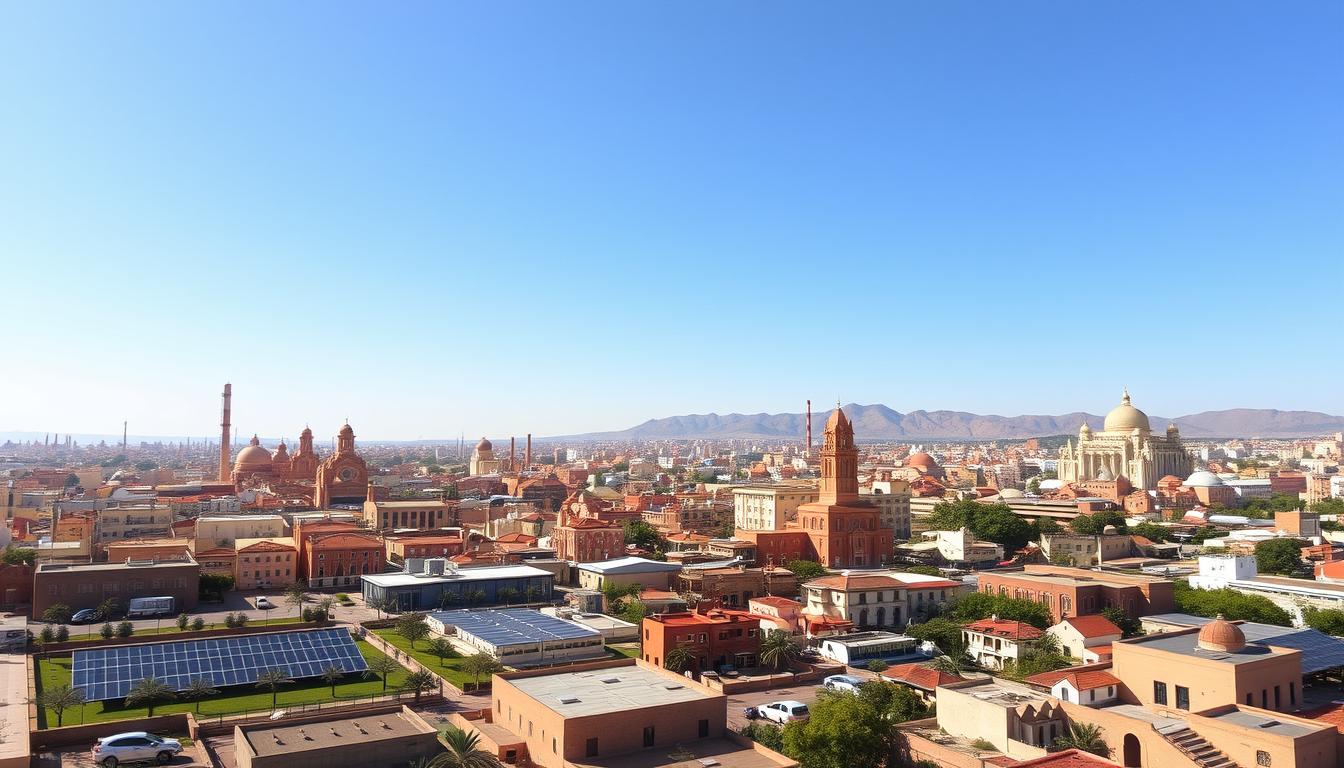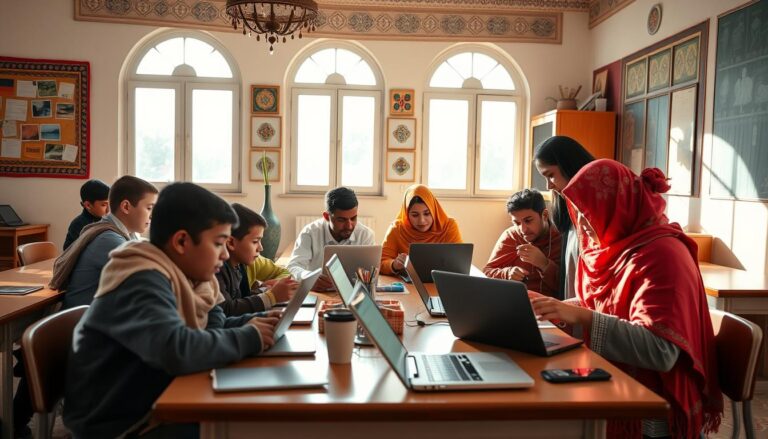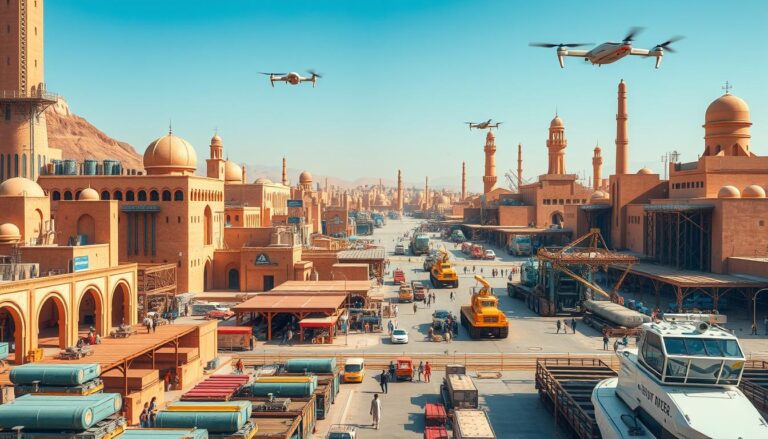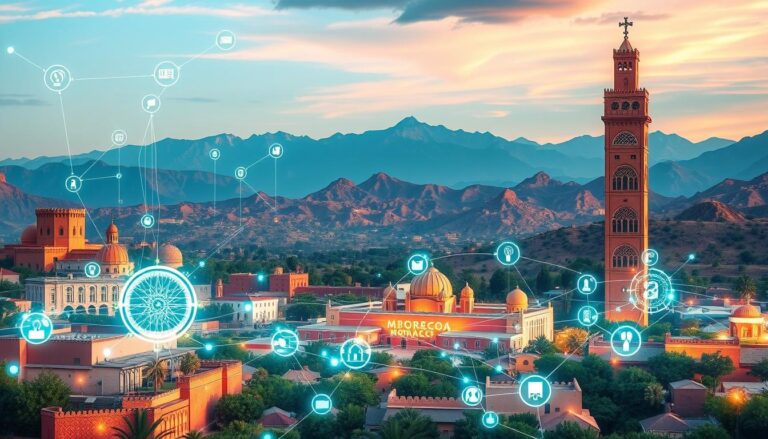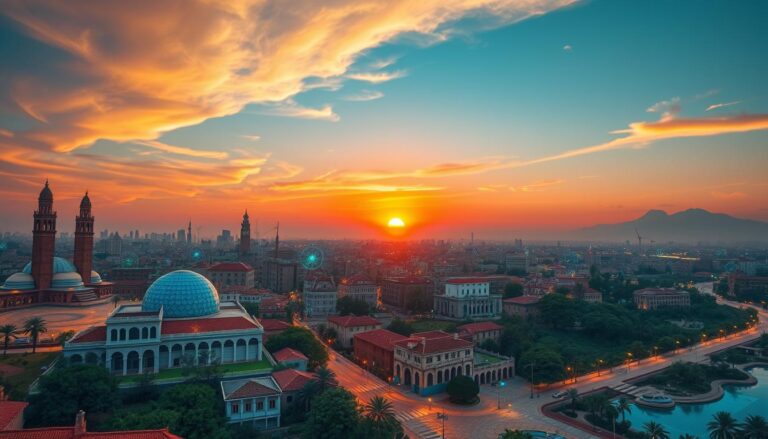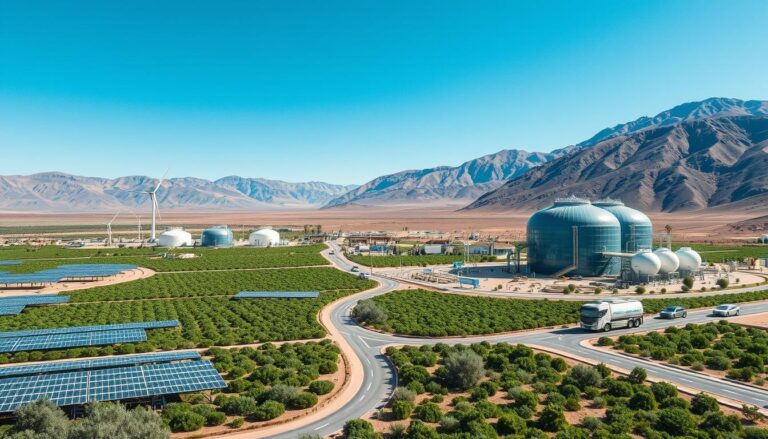How does a nation known for its rich history become a modern industrial leader? Morocco is moving towards 2030, becoming more than just a travel spot. It’s becoming a key player in the economy. King Mohammed VI’s modernization agenda is at the heart of this change, starting in the late 1990s.
Since 1999, King Mohammed VI has led Morocco to great human development achievements. Life expectancy has gone up by nine years, to about 75 years. Income per person has doubled, and years of schooling have increased from 8.1 to 14.6.
The absolute poverty rate has dropped from 15.3 percent in 2001 to 1.7 percent in 2019. People in rural areas now have better living conditions, with more electricity and water.
Yet, challenges persist, especially from the COVID-19 pandemic and the 2023 earthquake in Haouz. Despite these, Morocco is moving forward.
Now, Morocco aims to become a middle-income economy. The focus is on structural transformation. This means growing the economy, investing in people, and being sustainable. Morocco is ready to face the challenges of a changing world.
Join us as we explore Morocco’s plans for job creation, innovation, and fair progress.
Introduction to Morocco’s Industrial Development Plan
Morocco has seen rapid growth in recent years. This is thanks to smart industrial reforms and investments. The Industrial Development Plan sets big goals to improve human development and change the country’s structure.
Historical Context
Since 1999, Morocco has changed a lot. It has focused on better infrastructure and quality of life. The country has seen less poverty and better social conditions, thanks to manufacturing and sustainability.
The Industrial Acceleration Plan from 2014 to 2020 helped create over 700,000 jobs. This made Morocco important in global markets.
Goals and Objectives
Morocco wants to grow its economy by 6 percent each year. It aims for half of its industrial value to come from high-tech sectors. By 2035, it hopes to double its GDP per capita and increase formal jobs.
The plan also wants 75 percent of 15-year-olds to have basic skills. This is to ensure long-term human development.
Renewable energy is a big part of the plan. Morocco aims for 40 percent of its energy to come from clean sources. The digital sector is also key, aiming for a 5 percent GDP share by 2035.
Fixing a $37 billion infrastructure gap by 2040 is crucial. This will help Morocco grow sustainably.
“Morocco’s compelling vision for 2030 encompasses economic reforms, social and spatial equitability, and resilience against external shocks.”
The Moroccan government is committed to economic and structural change. It’s investing in infrastructure, like port upgrades and tram lines in Casablanca. This approach keeps Morocco on track for long-term success.
Roadmap for Strategic Industries
Morocco has a detailed plan to boost strategic industries. It focuses on the automotive and aerospace industries. With its location and Tanger Med port, Morocco is now part of technology-intensive global value chains. This move has brought in a lot of foreign investment, helping Morocco grow faster than others.
The Industrial Acceleration Plan 2014–2020 played a big role in this success. It helped the manufacturing sector grow and brought in a lot of Foreign Direct Investments (FDIs). By growing the automotive industry, Morocco did better than expected, even when many countries were losing jobs in factories.
Morocco wants to be a big player in certain areas. The automotive sector has grown a lot, thanks to experience and investments. The aerospace industry is also moving fast, making Morocco a key place for aerospace work in the region.
Morocco also has a strong network of international friends. It has a long-standing relationship with the United States, which has helped trade between them grow. Morocco’s New Development Model (NDM) also aims to make the economy more diverse, focusing on tech, mining, energy, and tourism.
This plan has worked well, keeping the manufacturing sector’s share of GDP around 15 percent. Morocco plans to keep pushing these industries forward. This will help Morocco stay strong in technology-intensive global value chains and use its industrial strengths to the fullest.
Investment Opportunities Analysis
Morocco’s economy is growing fast, offering many investment opportunities. These chances are especially good in key sectors that are growing quickly and are very important.
Key Sectors for Investment
The automotive industry, aerospace, and renewable energy are big draws for investors. Renault and PSA have made Morocco a top car maker in Africa. The Tanger Med Zones, with their industrial free zones, make it even more appealing for foreign investors.
The renewable energy sector is also growing fast. The Moroccan government wants to use more green energy. It aims to increase renewable energy’s share from 19.5% in 2021 to 40% by 2035.
Foreign Direct Investments (FDI) Trends
Morocco is a top choice for FDIs in Africa. In 2022, it drew $2.1 billion in FDI, a bit less than the $2.2 billion in 2021. The manufacturing sector FDIs made up 23.6% of FDI stocks in 2021.
The main FDI sources are France, the United Arab Emirates, Spain, and the United States. Morocco has 72 investment treaties and 62 economic agreements. These agreements make it easier for FDIs to come in and help avoid double taxation.
Morocco’s partnerships, like the Free Trade Agreement with the United States, are key. The U.S.-Morocco FTA has cut tariffs on most goods. This has led to a big increase in trade between the two countries. It shows Morocco’s dedication to being a good place for foreign investors.
Enhancing the Manufacturing Sector
Morocco is working hard to grow its manufacturing sector. This is a key part of the country’s growth plan. The sector makes up one-third of the country’s GDP and has stayed stable for 40 years. But, there’s a big chance to grow, especially in making medium-tech and high-tech products.
Morocco has 140 industrial parks, some over 100 years old. Thanks to the Millennium Challenge Corporation (MCC), the country is updating its industrial parks. This includes a $131 million investment to make the sector more competitive.
The MCC also gave Morocco a $10 million grant. This grant could lead to $160 million in loans and $200 million in green investments. Morocco also updated its plan to cut greenhouse gas emissions by 2030. This shows the country’s commitment to being green and growing its industry.
Morocco’s industry is strong in areas like aviation and cars. The aviation sector has 142 businesses, employing 17,000 people and making $2 billion in exports each year. The government wants to double this number by 2030.
Almost a quarter of Morocco’s workforce works in industry. But, there’s a big difference between foreign companies and local small businesses. To help local businesses, the government is working on new strategies.
Most of Morocco’s manufacturing companies are young, with three-quarters under 20 years old. This shows a modern approach to making things. Morocco aims to become a center for medium-tech and high-tech products, which could lead to more innovation and growth.
Digital Transformation and Economic Growth Initiatives
The “Digital Morocco 2030” strategy aims to make Morocco a digital leader. It has a $1.1 billion budget to create 240,000 jobs. This will train 100,000 young people every year.
This plan boosts digital skills, helping young entrepreneurs and driving innovation. It’s a big step for Morocco’s economy.
Digital Morocco 2030 Strategy
Morocco’s digital plan focuses on better digital services for everyone. It’s especially important in health, education, and jobs. The Unified Administrative Services Portal makes things easier.
By 2027, Morocco wants to triple the number of digital graduates. It has already doubled by 2024. The goal is to have 70% 5G coverage and connect 5.6 million homes to fiber by 2030.
Digital hubs and partnerships with groups like ANDE will speed up this change. They help Morocco grow digitally.
Employment Generation in Digital Sector
The “Digital Morocco 2030” strategy also aims to create jobs in the digital field. It wants to make 130,000 jobs in IT by 2030. This will strengthen the digital economy.
Programs like “Agile Financing Tools” help startups grow fast. They get money quickly to compete globally. The Mohammed VI Tangier Tech City is another key project.
It aims to make Morocco a top tech and industrial center. It supports the goal of having one or two unicorns by 2030. The Bourse de Vie program also helps experienced people start their own businesses. This boosts growth and innovation in the digital world.
Becoming Part of Global Value Chains
Morocco is working hard to join global value chains. It’s investing in big projects like the Tanger Med port and high-speed rail. These efforts make Morocco a key player in global trade.
Global Value Chains (GVCs) are big, making up 60% of world trade and employing 453 million people. Morocco is doing well in this area. It’s more competitive than many African countries, thanks to GVCs.
The growth of GVCs is impressive, increasing by 8% each year. This is much faster than the global GDP growth rate.
Morocco’s industrial free zones are key to its success. They offer tax breaks and easy customs, drawing in foreign investment. In 2021, Morocco got the ninth-most FDI in Africa, with a 52% increase to $2.2 billion.
Morocco is close to Europe, just 14 km away. The Tanger Med port is a key trade hub. It has seen a huge increase in trade value, from $2071 billion to $9,976 billion between 1995 and 2018.
Morocco is not just updating its infrastructure. It’s also making its industry meet global standards. This makes Morocco a strong player in global trade and supports sustainable growth.
Sustainable Industrialization Objectives
Morocco is dedicated to sustainable industrialization. Its National Energy Strategy highlights renewable energy, energy efficiency, and regional integration. This approach aims to improve various sectors and meet global environmental goals.
Renewable Energy Goals
Morocco’s renewable energy strategy focuses on the Noor CSP complex, the largest solar power project. Renewable energy now makes up 37 percent of Morocco’s electricity. The goal is to reach 52 percent by 2030.
The development of green hydrogen and expanding wind and solar projects are key. These efforts support comprehensive sustainable growth.
Water Management and Conservation
Managing water scarcity is crucial for Morocco’s sustainable growth. The National Water Management Plan 2020–2050 aims to solve these issues. It includes investing in desalination plants to improve water supply.
Initiatives to reuse wastewater are also important. They help manage water resources effectively. This shows Morocco’s commitment to sustainable growth.
Morocco’s Position in a Multipolar World
Morocco sits at a key spot, connecting Africa and Europe. It has made big investments and formed diverse partnerships. This has made Morocco important in both local and global economies.
Regional and Global Partnerships
The EU-Morocco Association Agreement shows Morocco’s strong bond with Europe. It boosts trade, investment, and political ties. Morocco also has strong economic ties with sub-Saharan Africa, helping the region grow.
By joining China’s Belt and Road Initiative, Morocco has become a key player in international trade and investment.
Role in African Economic Integration
In 2017, Morocco rejoined the African Union, a big step for regional unity. Since then, Morocco has led efforts to strengthen economic ties across Africa. It’s involved in the African Continental Free Trade Area and has made investments in sub-Saharan Africa.
The Evolution of Key Industries
Morocco’s industrial scene is changing fast, thanks to the Industrial Acceleration Plan. The aerospace sector is growing a lot, thanks to investments and partnerships. This growth has created jobs and boosted the economy.
The automotive industry in Morocco is also booming. It’s now Africa’s biggest car producer and exporter. By 2025, it aims to make one million cars, doubling that by 2030. Big names like Renault, Stellantis, and Dacia are driving this growth.
Morocco is also focusing on renewable energy. It wants 52% of its energy to come from green sources by 2030. This move is part of its plan to use less energy and be more efficient.
Agriculture is a big part of Morocco’s economy, making up 12% to 17% of GDP and employing 45% of workers. Increasing productivity in this sector is crucial. At the same time, tourism is growing, making up 38% of GDP. These efforts show Morocco’s plan to build a strong and varied economy.
Source Links
- Morocco’s Long Road Toward Economic Transformation
- Digital Morocco 2030: the national digital transformation strategy
- No title found
- Morocco – Infrastructure
- The Industrial Revolution in Morocco under the reign of King Mohammed VI
- Sectoral strategies | CNEA
- Morocco – Investment Climate Statement
- Morocco – United States Department of State
- Morocco Works to Decarbonize Industrial Parks for a Greener Future
- Morocco keeps on attracting some of the giants of global industry | AGBI
- Morocco – Industrial Decarbonization Accelerator
- Moroccan Digital Transformation Strategy 2030:
- Morocco: Maximizing Economic Momentum and IP Innovation – SABA IP – Intellectual Property in the Middle East and Africa
- Morocco – United States Department of State
- Roadmap for an Inclusive SDG Financing Framework
- US Think Tank Underlines Morocco’s ‘Ambitious’ Modernization Program
- Carnegie Endowment for International Peace: Morocco, a Global Connector
- Morocco’s Economy & main industries
- Morocco emerging as key global production hub

The Editorial Team is a passionate group of Morocco enthusiasts dedicated to sharing the beauty, culture, and wonders of this captivating country. With diverse backgrounds and a deep love for travel, we strive to bring you engaging and informative content that inspires your Moroccan adventures. From uncovering hidden gems and sharing local insights to exploring mouthwatering cuisine and showcasing the vibrant lifestyle, our team is committed to providing you with valuable resources and exciting stories that enhance your exploration of Morocco. Join us on this journey as we celebrate the rich heritage and unforgettable experiences that make Morocco truly special.

